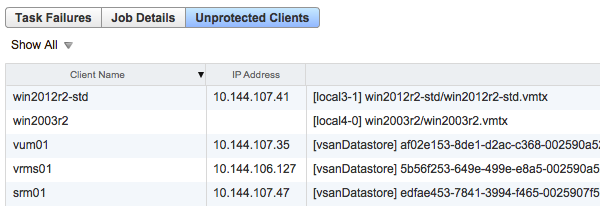Along with all of the announcements at VMworld 2014, I am happy to report on the latest versions of vSphere Data Protection (VDP) and vSphere Replication. As most of you may already know, there are two editions of VDP: VDP, which is included with vSphere Essentials Plus Kit and higher editions, and VDP Advanced, which is purchased separately. vSphere Replication is included with vSphere Essentials Plus Kit and higher editions. This article highlights the most prominent new features and updates in VDP Advanced and vSphere Replication.
VDP Advanced
Perhaps the number one feature request we heard was supporting the backup and recovery of databases on SQL Server AlwaysOn and Failover Clusters. The other was Exchange DAG support. With vSphere Data Protection Advanced 5.8, you get both! The VDP Advanced agents for SQL Server and Exchange have been updated to support these high availability solutions including the ability to select a replica backup policy such as “prefer secondary” for SQL Server AlwaysOn or “prefer passive” for Exchange DAG.
VDP Advanced has further enhanced its replication capabilities to enable “Replicate and Restore Anywhere”. Replicated backup data can be re-replicated – either back to the source location or another location. Examples – Scenario 1: I back up data at Site A with VDP Advanced and replicate the backup data to VDP Advanced at Site B. If needed, I could replicate that backup data (again) from Site B to Site C. Scenario 2: If Site A were to sustain a disaster and the original VDP Advanced appliance is lost, I could deploy a new VDP Advanced appliance, “Recover replicated backups” from Site B, and restore data in Site A.
It is now possible to deploy external proxies with VDP Advanced enabling more efficient backups in remote locations where the VDP Advanced appliance does not have direct access to the storage on which protected VMs are running, e.g., a separate cluster or remote site. An external proxy also supports VMs with Linux Logical Volume Manager (LVM) and EXT4 file systems.
Reporting has improved in VDP Advanced 5.8. If there is a task failure, detailed client log information can be viewed in the VDP Advanced UI and saved to a text file. In addition to information on backup jobs, replication jobs, and automated backup verification jobs, a list of unprotected clients, i.e., VMs not currently included in a backup job, is available. These reports can be exported to CSV files.
vSphere Replication
The primary new feature of vSphere Replication 5.8 is the integration of replication to a cloud provider such as VMware vCloud Air. When configuring vSphere Replication for a VM, the first step is selecting replication to a vCenter Server environment (on premise) or a cloud provider.
This makes it easy to configure, manage, and monitor vSphere Replication both on premise and to the cloud using the vSphere Web Client.
vSphere Replication reporting has also improved. Various graphs and charts are available including Replicated VMs (by VC), Replicated VMs (by Host), RPO Violations, and Transferred Bytes.
The items above are in addition to numerous bug fixes. Those details will be available in the release notes for each product.
Follow me on Twitter: @jhuntervmware























